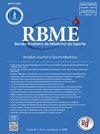高强度间歇训练对肥胖大学生体质和身体成分的影响
4区 医学
Q4 Health Professions
Revista Brasileira de Medicina do Esporte
Pub Date : 2023-03-30
DOI:10.1590/1517-8692202329012023_0050
引用次数: 0
摘要
摘要:保持身体成分和身体素质对大学生的健康至关重要。最近的数据表明,在年轻的大学生肥胖的增加和新技术已经研究来控制这种情况。目前的资源是高强度间歇训练。目的:探讨高强度间歇训练对肥胖男大学生体质和身体控制的影响。方法:以100名肥胖男大学生为实验对照,分为实验组和对照组。实验组进行高强度间歇训练,对照组进行一般有氧训练。收集实验前后12周的数据进行统计分析。结果:实验组男大学生的健康状况有统计学意义上的改善,健康指数有明显变化。坐姿前屈从5.91±5.16增加到9.47±5.27,闭眼站立平衡指数从5.87±5.58增加到10.47±6.08,跳远指数从1.96±0.15增加到2.14±0.21,仰卧坐姿从19.97±8.46增加到31.24±9.42,50米跑步时间从9.61±1.53缩短到8.53±1.25 s。结论:高强度间歇训练对肥胖大学生体质和身体成分均有积极影响。证据等级II;治疗性研究——对治疗结果的调查。本文章由计算机程序翻译,如有差异,请以英文原文为准。
EFFECTS OF HIGH-INTENSITY INTERVAL TRAINING ON PHYSICAL FITNESS AND BODY COMPOSITION OF OBESE COLLEGE STUDENTS
ABSTRACT Introduction: Maintaining body composition and physical fitness is important for the well-being of college students. Recent data indicate an increase in obesity among young college students and new techniques have been studied to control this situation. Among the current resources is high-intensity interval training. Objective: Explore the effects of high-intensity interval training on physical fitness and body control in obese male college students. Methods: The experimental control involved 100 obese male college students, divided into experimental and control groups. The experimental group participated in a high-intensity interval training protocol while the control group performed general aerobic training. Data before and after the experiment, which lasted 12 weeks, were collected and statistically analyzed. Results: The conditions of male college students in the experimental group were statistically improved, and the fitness index changed expressively. The sitting forward bending increased from 5.91±5.16 to 9.47±5.27, the standing balance index with eyes closed increased from 5.87±5.58 to 10.47±6.08, the long jump index went from 1.96±0.15 to 2.14±0.21, in the supine sitting position it went from 19.97±8.46 to 31.24±9.42, and the running time in 50 meters was reduced from 9.61±1.53 to 8.53±1.25 s. Conclusion: High-intensity interval training positively impacted both physical fitness and body composition in obese college students. Level of evidence II; Therapeutic studies - investigation of treatment outcomes.
求助全文
通过发布文献求助,成功后即可免费获取论文全文。
去求助
来源期刊

Revista Brasileira de Medicina do Esporte
PHYSIOLOGY-SPORT SCIENCES
自引率
0.00%
发文量
204
审稿时长
6-12 weeks
期刊介绍:
The Revista Brasileira de Medicina do Esporte (RBME in its Portuguese form) is an official organ of the Sociedade Brasileira de Medicina do Exercício e do Esporte (SBME) Brazilian Society of Exercise Medicine and Sports) and represents the main promotion resource of the scientific production in the Exercise Sciences and Sports Medicine (SBME) fields in our country. The RBME was launched in 1995 with trimester periodicity and became regularly bi-monthly published with no interruptions from 1999.
RBME is an inter-and multidisciplinary, peer reviewed, Open Access journal which accepts contributions from the national and international scientific community. RBME publishes original articles of high scientific relevance in Exercise and Sports Medicine, review articles, and systematic reviews.
RBME preferably publishes original articles of international interest, not only of regional significance. Its goal is to disseminate the scientific production in the areas of exercise and sports medicine through the publication of original research results and other documents that contribute to the scientific and applied knowlewdge of physical activity, exercise and sports, within the framework of biological sciences and medicina.
Its title abbreviation is Rev Bras Med Esporte, which should be used in references, footnotes and reference subtitles.
 求助内容:
求助内容: 应助结果提醒方式:
应助结果提醒方式:


